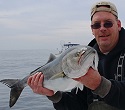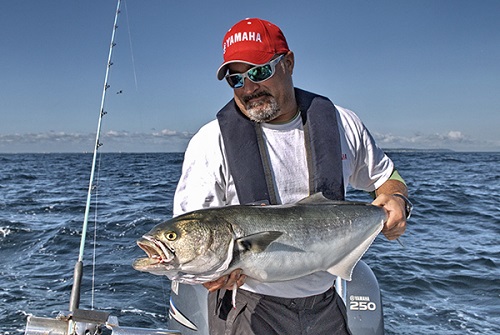 From the early reports, 2015 is shaping up to be a bonanza year for bluefish (#bluefish) along the Eastern Seaboard. Early spring has seen massive schools of these great gamefish moving into shallow bays from Maryland to New York. New Jersey’s Barnegat Bay, with acres of shallow flats and narrow, winding channels, has been chock full of big bluefish since late April, and they don’t seem in any hurry to leave. The same goes for estuaries further north and well to the south. While bluefish are frequent visitors to these bays in the spring, most years they are of the smaller variety, often called cocktail blues, running from two to five pounds. But this year, the full-size choppers are in and average eight to twelve pounds with some pushing the 20-pound mark. They are hungry, eager to hit anything from surface lures to bait, and are a real challenge on light tackle. And when you catch them in shallow water like this, they spend a lot of time airborne.
From the early reports, 2015 is shaping up to be a bonanza year for bluefish (#bluefish) along the Eastern Seaboard. Early spring has seen massive schools of these great gamefish moving into shallow bays from Maryland to New York. New Jersey’s Barnegat Bay, with acres of shallow flats and narrow, winding channels, has been chock full of big bluefish since late April, and they don’t seem in any hurry to leave. The same goes for estuaries further north and well to the south. While bluefish are frequent visitors to these bays in the spring, most years they are of the smaller variety, often called cocktail blues, running from two to five pounds. But this year, the full-size choppers are in and average eight to twelve pounds with some pushing the 20-pound mark. They are hungry, eager to hit anything from surface lures to bait, and are a real challenge on light tackle. And when you catch them in shallow water like this, they spend a lot of time airborne.

There are also large schools of blues along the beaches as well as out about a mile or two. Many anglers fishing for striped bass are encountering them and while they might not be the target species, they are great sport even on heavier trolling tackle. With so many big blues around this early in the spring, it bodes well for a banner year for bluefish. As the season progresses, schools could push as far north as Maine. As local inshore waters warm in early summer, they will begin to move to traditional summer haunts a few miles off the beach where they could remain throughout the summer and well into late fall, providing red hot fishing action both during the day and at night.
Bluefish (Pomatomus saltatrix) are unique in so many ways, but one of the most fascinating things about them is they are the sole species in their family (Pomatomidae). They have no close relatives and while they are frequently caught close to shore and even in bays and tidal rivers, they are classed a pelagic fish like tuna, dolphin and even marlin because they are highly migratory and can be found many miles offshore. It is thought that they even cross entire oceans in their wanderings. They are found in the temperate and subtropical waters of the Atlantic, the Mediterranean and even areas of the South Pacific off Australia. They inhabit both the east and west coasts of Africa, but are not found in the equatorial or northern waters of the Pacific or around Southeast Asia. Bluefish are known as tailors in Australia, shad on the east coast of South Africa, and elf on the west coast. They can grow to sizes well in excess of 20 pounds. The standing world record was caught off North Carolina in 1972 and hit the scales at a staggering 31 pounds, 12 ounces.

Light tackle and jigs catch bluefish in the ocean year round.
The bluefish is a purpose-built predator that travels and feeds in schools that are usually loosely segregated by size because the larger ones will eat smaller members of the species. They are handsome fish, with a deep yet streamlined body shape that makes them both fast and maneuverable. To enhance speed and reduce effort when cruising, the first dorsal fin folds back into a groove in their back and the pectoral fins fold tight to the body into indentations to make them even more hydrodynamic. Body coloration is a grayish blue-green dorsally, fading to silver and white on the sides and belly. Their bright yellow eyes are a signature bluefish trait, and so are the knife-edged dentures that adorn the top and bottom jaws. They use their sense of smell, keen vision, speed, and razor sharp teeth as their primary feeding tools. When attacking small baitfish, they typically swallow them whole, but blues will not hesitate to go after much larger prey like mature menhaden. They attack from the side or below, and bite off the tail to prevent it from getting away. Then, they double back to take a few more bites from the immobilized prey. When an entire school is feeding, the intensity can be ramped up to the point where they kill on the first bite and move off to another victim. Such encounters between massive schools of baitfish and large groups of bluefish are called a feeding frenzy or blitz, and it is an amazing thing to see.
Bluefish are probably the most obliging gamefish in the ocean. While there are times when they can get finicky, for the most part they will readily hit a lure, or live or dead bait. Pound-for-pound, they are one of the hardest fighting fish you’ll tackle. When they move into shallow estuaries, you can catch one after another on surface plugs, jigs and small metals. Anything that looks even remotely like a baitfish can get their attention, and once they see it they typically try and eat it. In ocean waters, they will hit trolled lures, a wide variety of metal jigs like the traditional diamond jig, poppers and plastics, but you’re best off using lures that are relatively tooth proof (and if it’s something small enough for them to swallow, use a wire leader.) As they move further offshore in the summer, chumming with ground menhaden will attract them and put them in a feeding mood. You can simply drift a chunk of menhaden on a hook with a short trace of wire leader so the fish can’t bite you off, and you’ll be catching in no time.
Depending on how far north you fish, there is a period during late spring or early summer when the medium and large fish will disappear from inshore grounds for a week or two. That’s when they move a little further offshore to spawn. Large aggregations of them can be found 20 or so miles out milling around on the surface, often with their dorsal fins sticking out of the water. When some internal signal goes off, they spawn in mass and the surface water gets thick with eggs and milt that will become the next generation of these great gamefish. Those small ones will drift on the currents, but will be back in estuaries and tidal rivers by early fall, turning into tiny snapper bluefish and tearing up anything small enough for them to bite. They can be as big as six inches by the time they start heading south again with the coming winter. The larger fish will hang in and frequently be caught along with striped bass well into December and even January along the Mid-Atlantic coastline.

A medium to large bluefish can make quick work of a menhaden, chopping it in half with a quick bite or two.
Tackle for bluefish can be pretty much whatever you have, but some effort should be made to match the rod, reel and line to the size of the bluefish that are most prevalent. Fishing with heavy tackle for small bluefish is no fun, and fishing too light for big blues means a very long fight that puts a strain on the fish if you are planning to release it. If you enjoy fly fishing, bluefish might become one of your favorite gamefish. They are quick to pick up most baitfish-sized flies, and will make you work hard to beat them.
Smaller bluefish make fine table fare, but the larger specimens have soft, grayish flesh that can taste very strong. To make them more palatable, immediately bleed any fish you want to keep by cutting the gills and placing them in the splash well of the boat to bleed out. Then get them on ice quickly and when you fillet the fish, leave the skin on. Before cooking, cut away the dark red strip down the center of the fillet. They are best when served fresh, spiced nicely and baked or cooked on a grill with the top closed.
Here’s hoping the early start to the 2015 season continues throughout the summer and into the fall, and that fishermen from the Carolinas to New England all get the chance to get in on some great fishing – every indication is this will be a banner year for bluefish! Y

There’s a jig in this selection of metals that range from 1/2 to 4 ounces that will catch any size bluefish in bays or the ocean. There’s something here to match almost any baitfish they might be feeding on.

